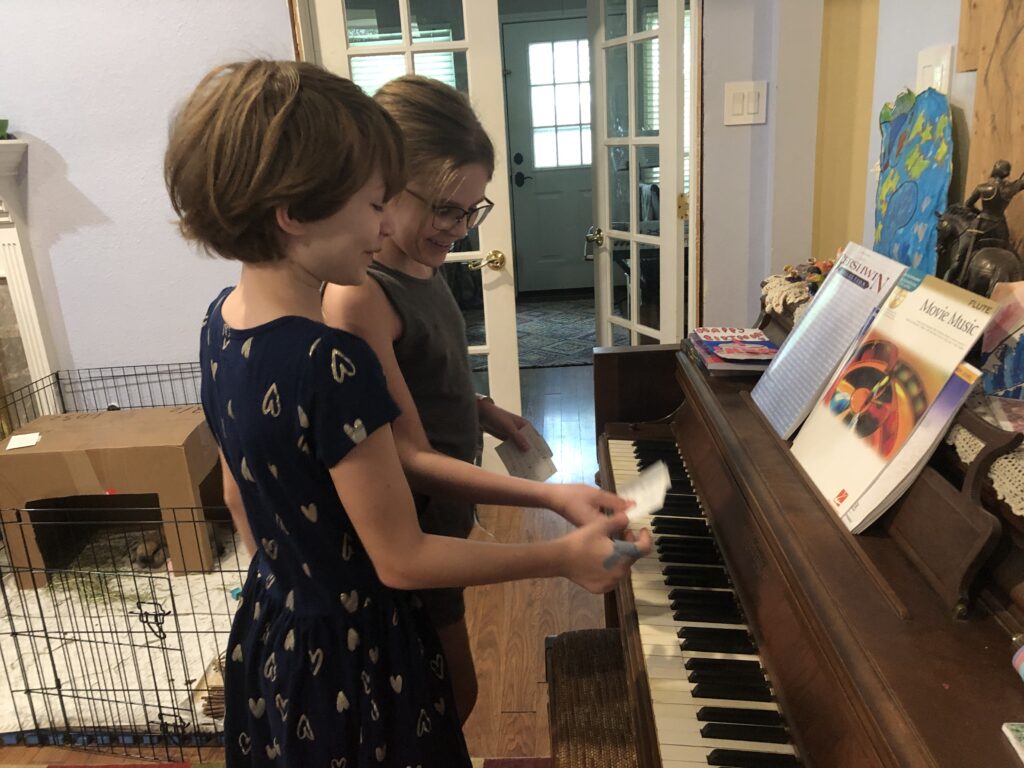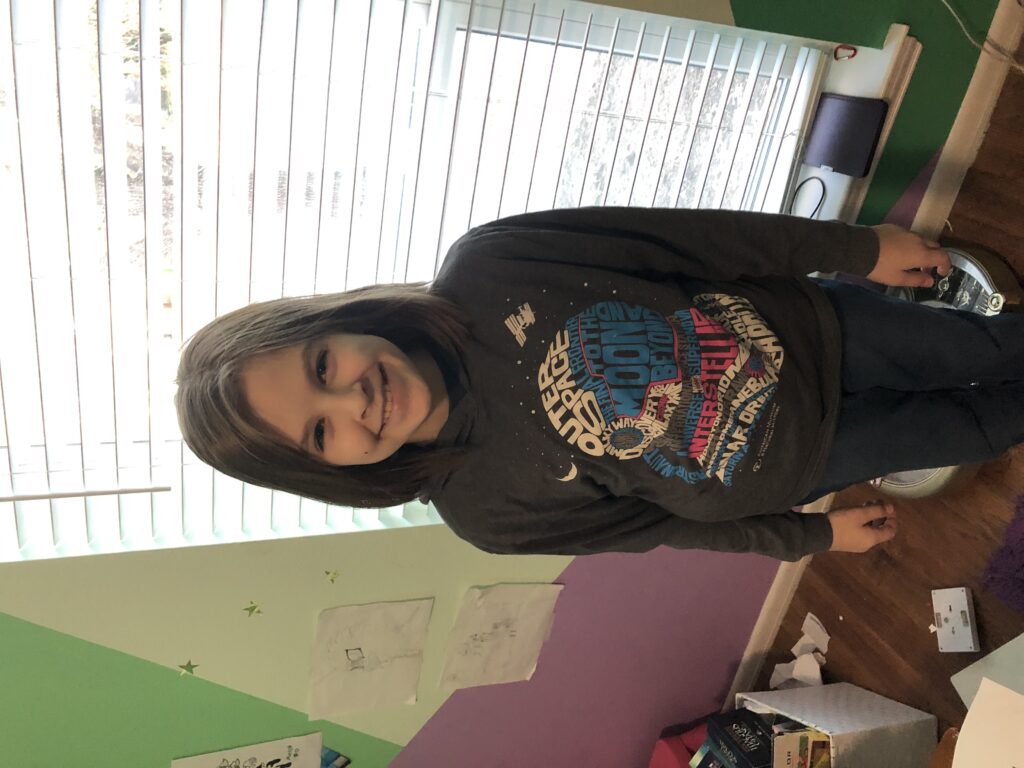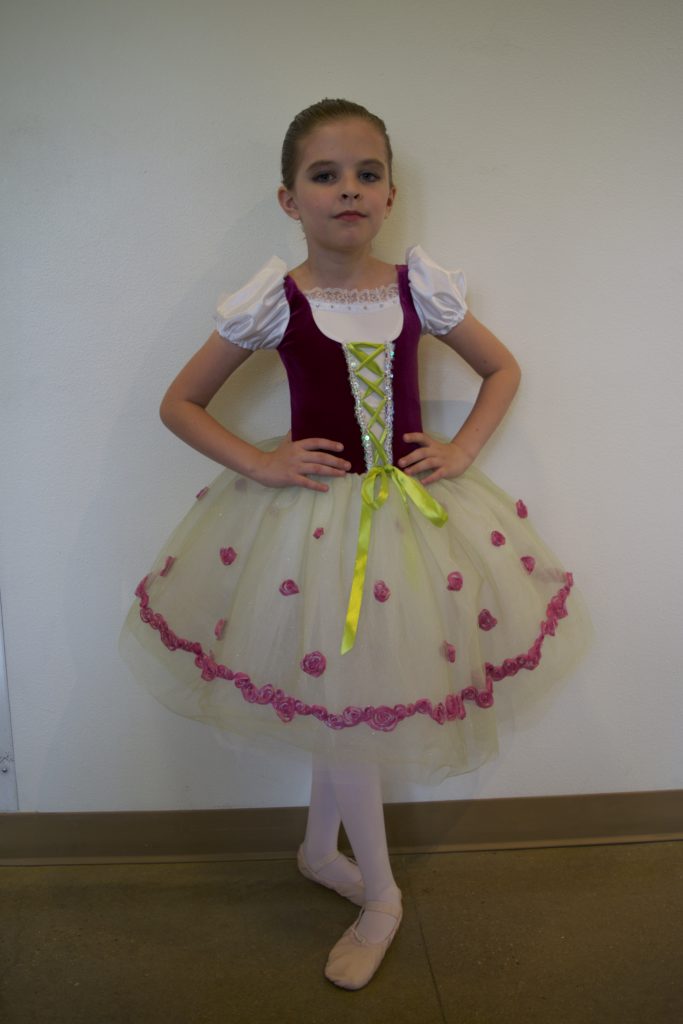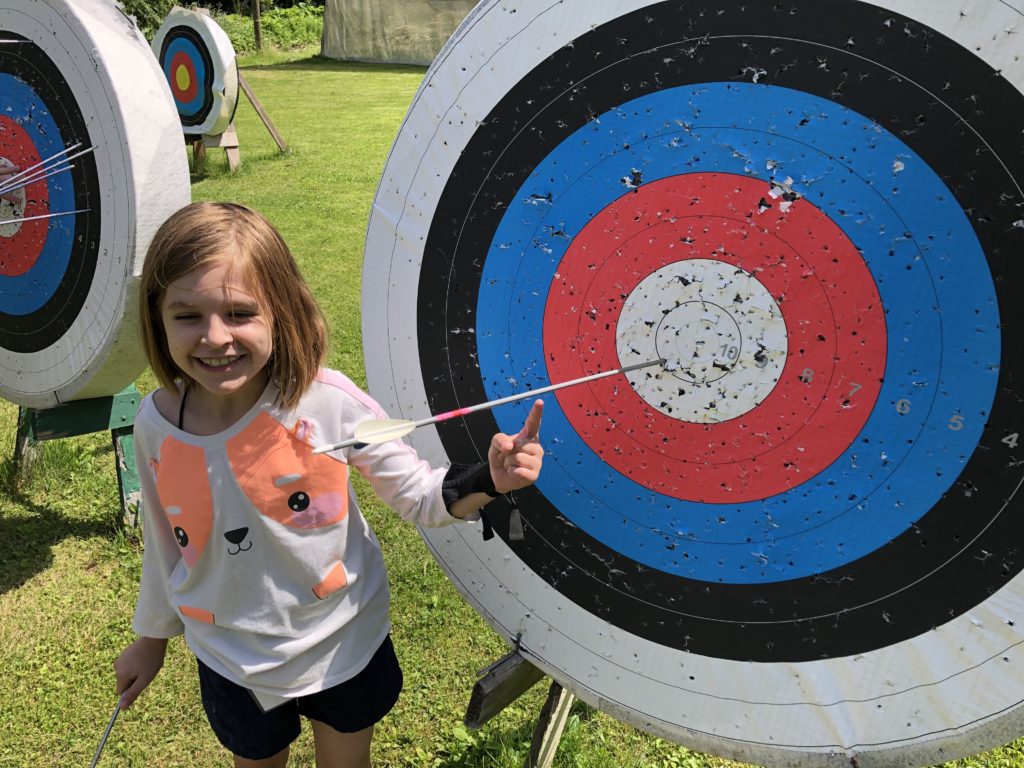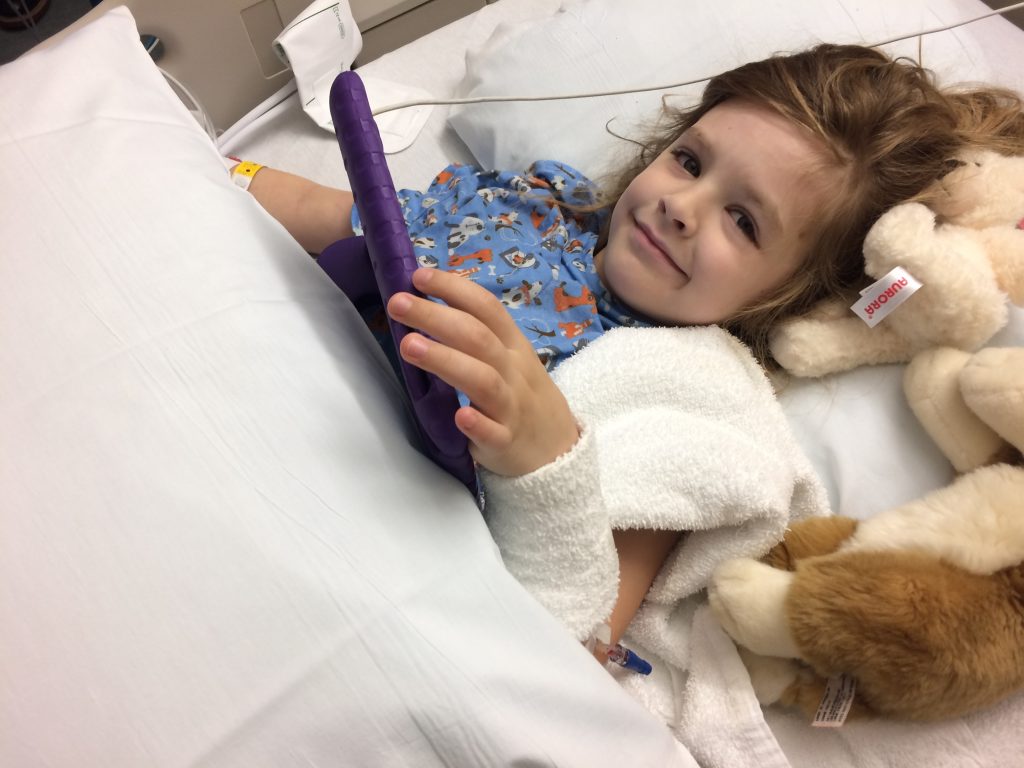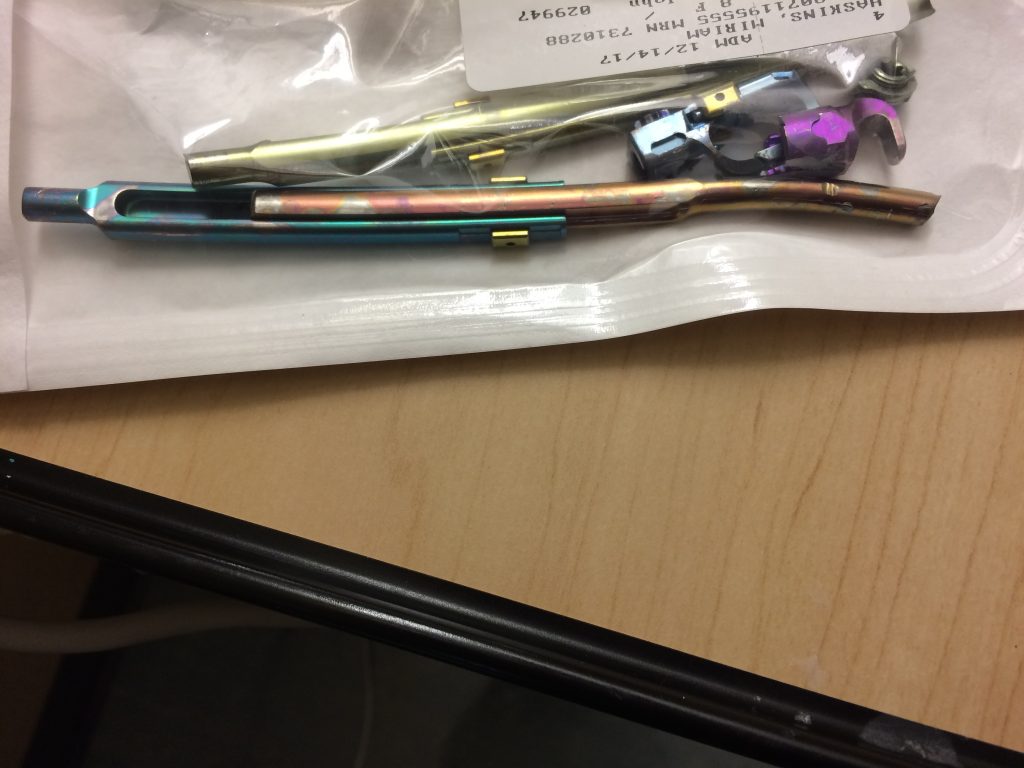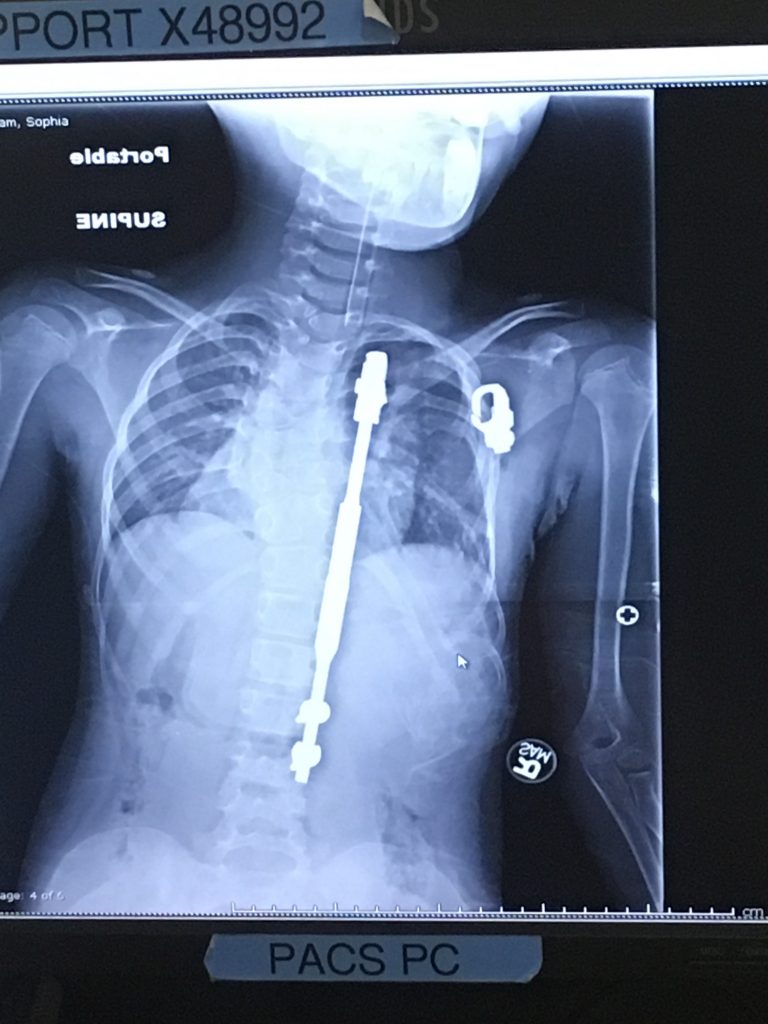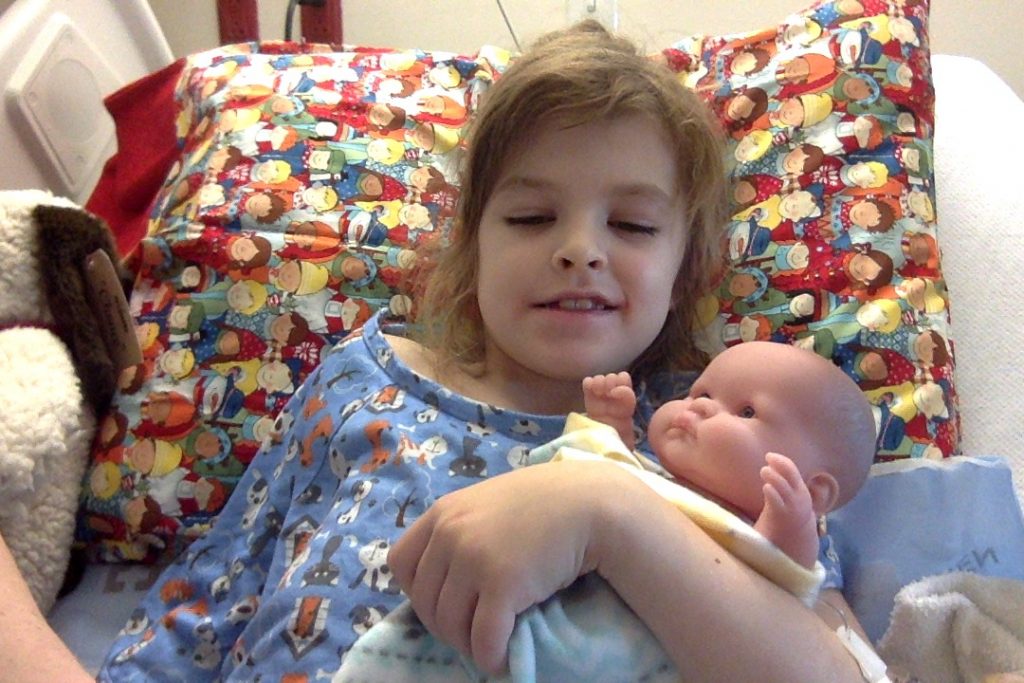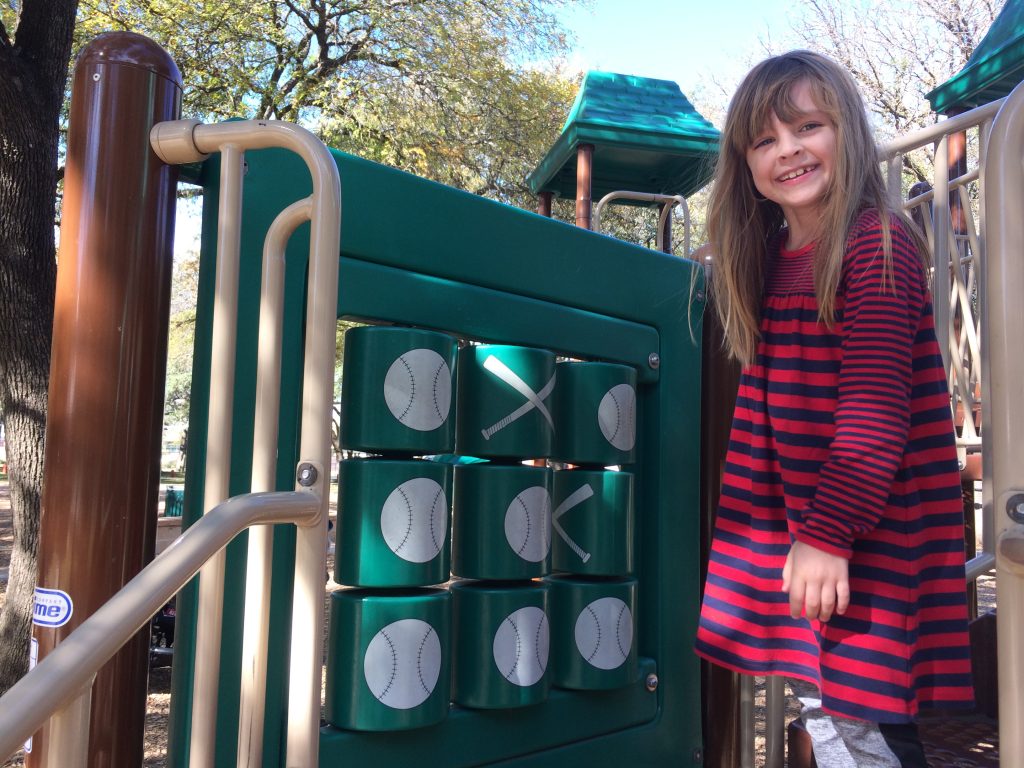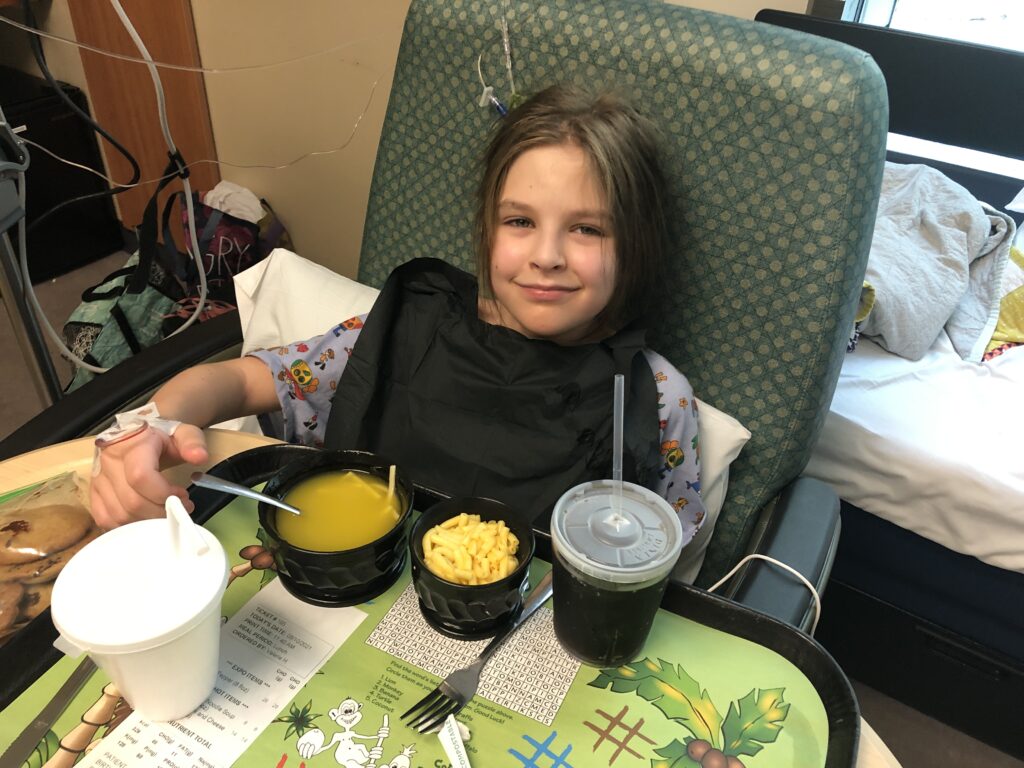 Miriam was released from the hospital after two nights and has been resting comfortably at home since yesterday afternoon. We got the call from her surgeon today to let us know that the cultures from her surgical site didn’t grow anything, so she did not have an infection and no further intervention is needed. We will still check in with Dr. Williams over the coming years to monitor her curve, as fusion is still definitely a possibility. For now, however, she gets to live hardware-free for the first time in nearly nine years! And once her incisions heal, she’ll be able to stretch and rotate her back with a full range of motion for the first time ever!
Miriam was released from the hospital after two nights and has been resting comfortably at home since yesterday afternoon. We got the call from her surgeon today to let us know that the cultures from her surgical site didn’t grow anything, so she did not have an infection and no further intervention is needed. We will still check in with Dr. Williams over the coming years to monitor her curve, as fusion is still definitely a possibility. For now, however, she gets to live hardware-free for the first time in nearly nine years! And once her incisions heal, she’ll be able to stretch and rotate her back with a full range of motion for the first time ever!
All clear!
Hardware is out; waiting on tests
 Miriam’s surgery to remove her MAGEC rod and remaining attachment cradles was successful this morning. However, when Dr. Williams made the incision over the rib attachment at the top of the rod, he found a sac of fluid (a bursa) and irritated bursal tissue surrounding it. He sent samples of both off for initial lab testing while removing the hardware, and they came back with no immediate signs of infectious organisms but an unexpected, though moderate, level of white blood cells. This could be just from her body trying to protect itself, as this is the area where Miriam’s scapula had been colliding with the cradle for the last several months. On the other hand, Dr. Williams wants to know whether Miriam has been carrying a low-level infection before sending her home from the hospital, because a positive result would mean she needs four weeks of IV antibiotics given through a PICC line. We are admitted in the hospital at least until the culture results come back, which should be Wednesday or Thursday. He also sent her out of surgery with a wound vac to drain any additional fluid, which should probably come out tomorrow.
Miriam’s surgery to remove her MAGEC rod and remaining attachment cradles was successful this morning. However, when Dr. Williams made the incision over the rib attachment at the top of the rod, he found a sac of fluid (a bursa) and irritated bursal tissue surrounding it. He sent samples of both off for initial lab testing while removing the hardware, and they came back with no immediate signs of infectious organisms but an unexpected, though moderate, level of white blood cells. This could be just from her body trying to protect itself, as this is the area where Miriam’s scapula had been colliding with the cradle for the last several months. On the other hand, Dr. Williams wants to know whether Miriam has been carrying a low-level infection before sending her home from the hospital, because a positive result would mean she needs four weeks of IV antibiotics given through a PICC line. We are admitted in the hospital at least until the culture results come back, which should be Wednesday or Thursday. He also sent her out of surgery with a wound vac to drain any additional fluid, which should probably come out tomorrow.

Dr. Williams said that he got a clearer image of the curve in her thoracic vertebrae after the rods were removed, and he was strongly considering proceeding with the fusion of just that section of her spine. However, he did not want to insert new hardware if there was any risk of infection, so he stopped after removing the existing hardware. We will proceed as planned with waiting and monitoring the spine every 4 – 6 months. If her thoracic spine does resume curving – especially because she has not yet had her final growth spurt – we will then proceed with a fusion (but no sooner than next summer).
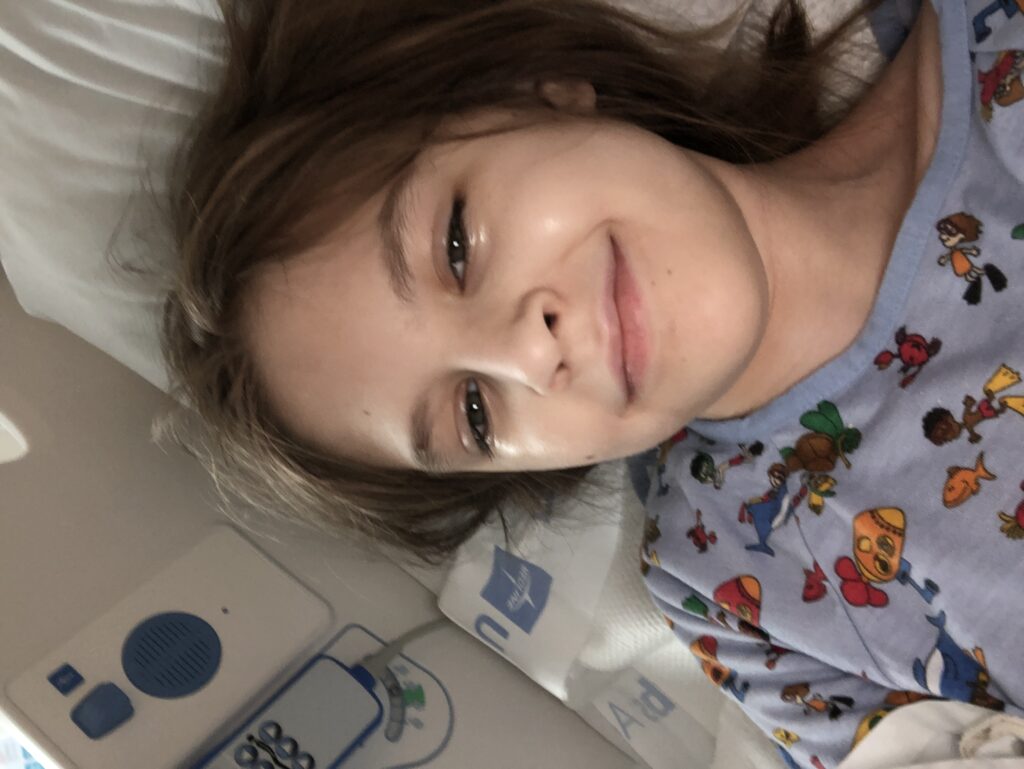
Thankfully Miriam has been recovering well from the procedure so far. She has walked on her own to the bathroom and has had drinks and a few crackers. Her pain seems well-controlled overall. The hospital has added a few new procedures to their surgery regimen which seem to have helped, including “carb-loading” two hours before arrival (meaning I had to wake her up at 3:15 this morning to drink 12 ounces of Powerade). They also gave her doses of Tylenol, Gabapentin, and Valium before she headed back to surgery, and Dr. Williams used a numbing medication on her incisions, all of which are supposed to reduce the need for narcotics as she recovers. She is currently on low doses of Dilaudid and Toradol, which seem to be controlling her pain but not making her too sleepy.
Thank you for your love and prayers – they do so much for her and us during this recovery stage. We continue to pray that her care team makes the best decisions for her long-term health and that she remains comfortable during these first days of healing.
Removing MAGEC
Monday (Aug. 9) will be a big day for Miriam. After 3 ½ surgery-free years and more than a dozen successful expansions of her MAGEC rod, it is time for removal. The rod is nearly fully expanded, and we are concerned that her rib attachment could be damaged by any more expansion attempts. She had pain in the front of her chest in June that was severe enough for us to take her to the ER. Tests ruled out any dangerous issues, but the CT they took of her chest showed some indication that her rib may have cracked or eroded at the attachment point on her back. The pain in the front of her chest could have been either radial nerve pain spreading from that injury, or due to the rib shifting in the front of her chest in response. Either way, her surgeon decided our next best step would be to remove the MAGEC rod and the remaining attachment clip currently under her right armpit, left over from her previous VEPTR rods.
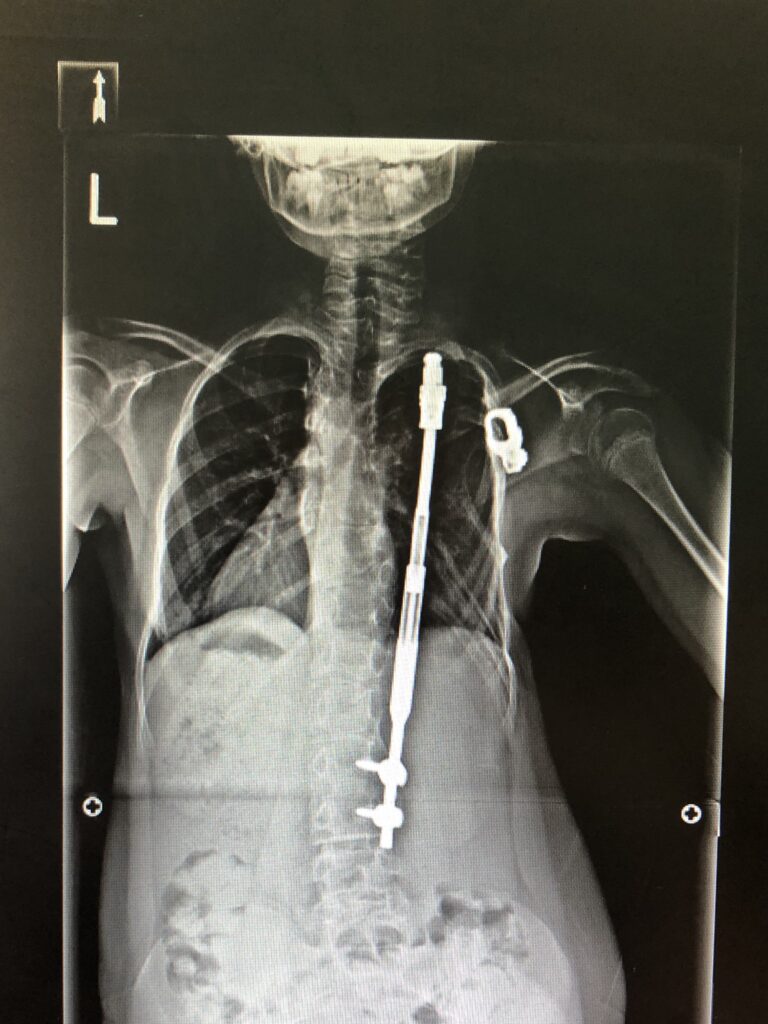
The big question of this surgery is what will happen next. Miriam has had AMAZING correction over the last few years, to the point that she does not really have a remaining curve. What we don’t currently know is how much of her spine has already auto-fused. Given how long her spine has been stuck in the same position, Dr. Williams believes it is likely that many of her vertebrae have already grown together. His primary plan for Monday is to simply remove her current hardware and then monitor her over the next several years to make sure that her spine does not resume curving. However, he will have all of the equipment ready to proceed with traditional fusion surgery if there are indications that her spine is going to immediately begin to curve once it loses the support of the rod. While this would require a longer recovery, it would mean avoiding another surgery down the road if the curve progresses and we potentially lose some of the straightness she has achieved.
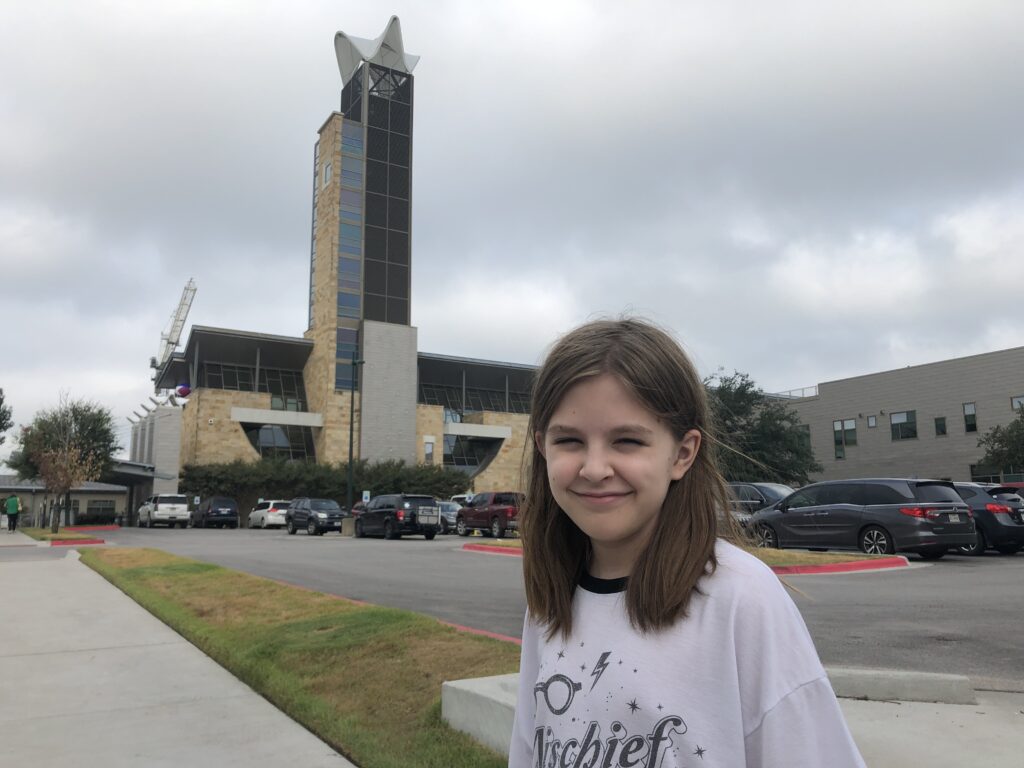
Recovery will depend on which level of surgery she endures. If the surgeon removes her current hardware but does not do any further intervention, she would likely only stay in the hospital one or two nights. The only healing necessary would be the soft tissue from around the rods and her incisions, so she should be back to a regular schedule pretty quickly. If Dr. Williams decides to proceed with spinal fusion, the hospital stay would be 2 – 4 nights and her post-op activity restrictions would be higher for several months. She is supposed to start school on Aug. 18, so the shorter recovery would be helpful. However, we want to do whatever will be best for her in the long run, so we are praying for divine wisdom to guide her surgeon’s decisions in the OR.
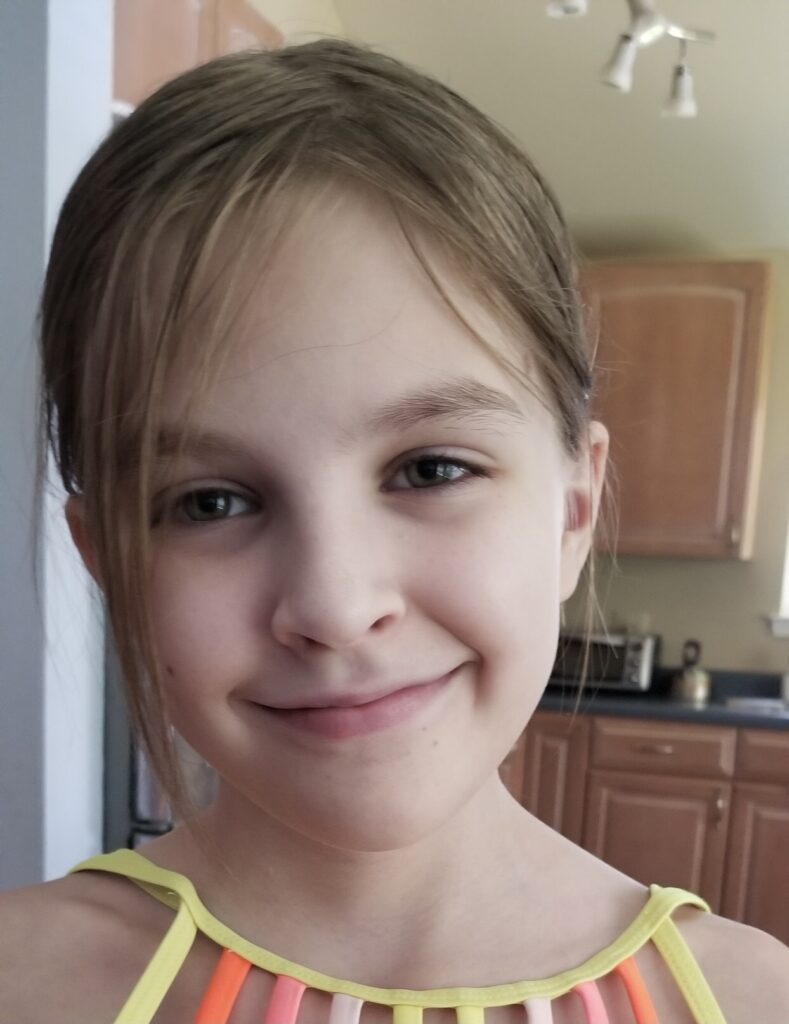
Miriam is now 12 ½ and beginning seventh grade. She has been fully vaccinated against Covid-19 since the beginning of June, which is the only reason we are sending her to school despite her reduced lung capacity. This year will be her first experience attending class at her middle school, since she spent all of sixth grade learning virtually. Those who know Miriam won’t be surprised that she was amazingly resilient through all the struggles and disappointments of the last year and a half. She achieved all A’s and independently completed all her work in her online classes. She co-founded a weekly online art club and founded an online Dungeons and Dragons group with classmates (which she has continued to lead as Dungeon Master through the summer). She also won two highest-level medals in a juried art contest, and wrote multiple fantasy and sci-fi novellas for fun in between her classes.
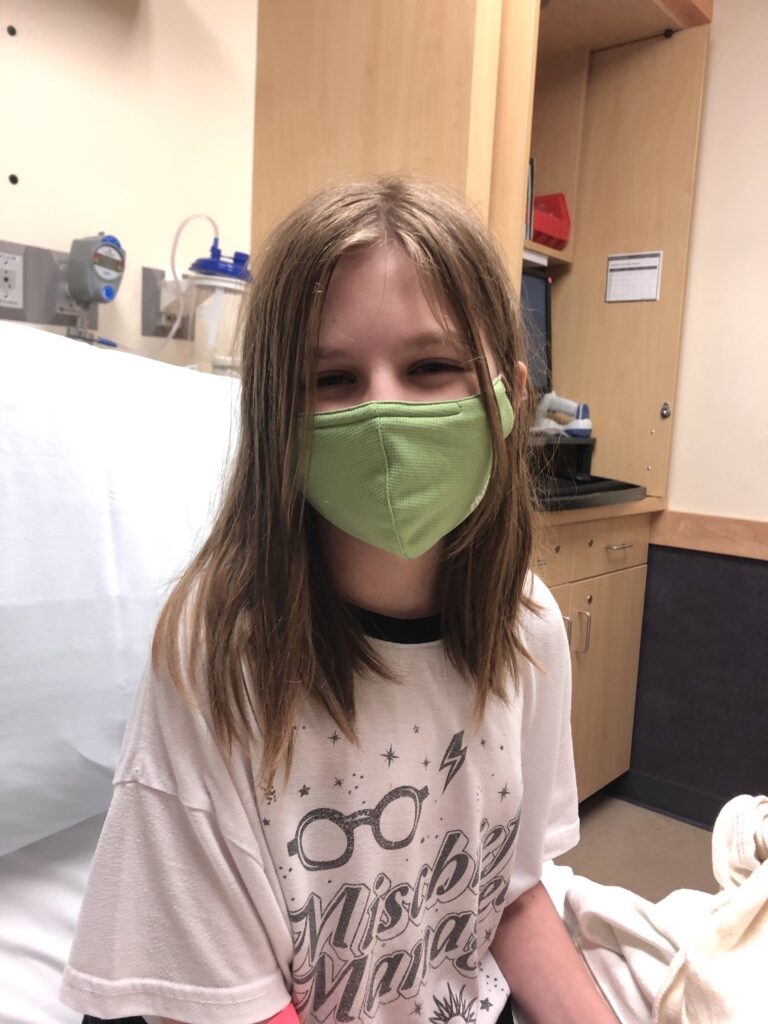
Her brave and cheerful attitude has continued as we prepare for this surgery. She was anxious about having her blood drawn for the first time in years at her pre-op appointment, but thanks to the amazing nurses at Dell Children’s Hospital she was smiling as they finished. She has had an elevated level of discomfort and pain from the rod over the last several months, as the upper connection point is directly in the path of her right shoulder blade. She is ready to get that equipment out so that she doesn’t have to feel it rub and pop every time she pulls her arm back. She is also excited about the possibility that this could be her last surgery, as are we. We greatly appreciate prayers for her safety, for wisdom and precision for her surgical team, and for easy and swift healing after the procedure. We are so grateful for the incredibly healthy young woman she is growing into, and for the doctors, nurses, and other medical experts that have helped her through this journey. We will keep you updated through her procedure and recovery.
From Miso
Hi! Aren’t things scary right now? My school is canceled until May 4th! But I wanted to tell you that I’m happy that all of you are here supporting my medical journey and that I’m grateful my doctors made me pretty normal. Plus, I have a whole group of Austin friends, the Curvy Girls, who have similar life stories. But nothing major is happening right now. Nothing is supposed to happen until two years from now, when I might get fused. And the pandemic has yet to hit close to home. And I just found out my neighbor makes reaaaaaaaaaaaaaaaally good vegan donuts. Yum!
Miso
18 months with MAGEC
In honor of Scoliosis Awareness month (although we’ve just missed the end of it), we want to update Miriam’s story to share how well she is doing with her MAGEC rod. It has now been over 18 months since the surgery where her doctor switched her hardware from two VEPTRs to one MAGEC rod. Miriam has had six expansions of the rod so far. The expansions take place during a visit to her orthopedic surgeon’s office, where a remote control containing a magnet is placed directly over the rod in her back. The magnet makes the magnet inside her MAGEC rod rotate, which very slowly expands the rod. Miriam always feels a little uncomfortable during the procedure and is sometimes sore for a day or two afterwards, but it’s a lot easier than recovering from surgery! Here is a video of her first expansion if you’d like to see how quickly it happens.
Miriam goes for expansions every three months. She started out getting three millimeters with each of her first few expansions, but the last three have all gotten less than 2. There is a safety on the remote that prevents it from pushing past a safe level of tension, and that has been stopping the expansion around 1.7 mm. It seems like that is the maximum her body can tolerate, and since her growth curve is on the small end her doctor isn’t concerned. As long as the rod can keep expanding, it is doing its job. And on the positive side, slower expansions mean this rod can last longer in her body, further delaying any need for future surgery.
Speaking of future surgery, Miriam’s likely next step in 18 – 24 months will be spinal fusion. Sometimes MAGEC patients swap out their rods for larger ones when they reach maximum expansion, so there is a small chance that could happen if it seems she still has a lot of growth potential left. However, her doctor has let us know that most spinal growth for girls is done by age 12 (the rest is mostly in the legs). If she can make it there on this rod it probably won’t benefit her much to keep trying to expand. The spinal fusion will be a major surgery. We haven’t gone over it in detail with her doctor yet, but given the complexity of her vertebral anomalies we expect her entire thoracic spine will require fusion. We’ll share more when we know more details, but feel free to start your prayers now!
There have been many achievements in Miriam’s life over the last 18 months. She has continued to excel in all of her subjects in school, including reading and writing in Spanish in her dual language classes. She recently completed the fourth grade and performed in her fifth ballet recital this spring. We just returned from a wonderful family vacation to upstate NY and NYC, where Miriam swam almost every day and fell in love with archery. We’ve now had two summers and a Christmas without sweaty bandages or healing incisions that need to be kept dry, and Miriam has enjoyed the freedom! Thanks as always for your thoughts and prayers. You support her and us through the hard times and the joyful ones, and she knows she never faces her challenges alone!
THANK YOU from 10 year old miso
All of you have prayed for me, loved me, and cared for me so much that everything I do will not be enough! Thank you! ;) <3 Miso
Project for Awesome fundraiser
There are less than 24 hours remaining for voting in the annual Project for Awesome fundraiser on YouTube. Miriam and her sisters made a fundraising video for her hospital, Dell Children’s Medical Center of Central Texas. Please click below and vote for their video before Sunday at noon (less than 24 hours to go!). All of the money raised will be split between the most-voted charities. Please vote and share with your friends!
Exchange of VEPTR for MAGEC, with an added surprise
Surgery yesterday began at 8 am and went until 1 pm. Dr. Williams started by checking on the rib-to-rib VEPTR, and discovered that the bottom anchor of that rod had also migrated through the bone. In other words, she hasn’t had either rod holding her up for a month or more. There were no good places to reconnect the rod, and obviously her ribs have not been collapsing without the rod’s support. He decided to just take it out. He left the upper anchor in for now, just in case her chest does begin to collapse and we need to put in a new rod.
He then removed the long rib-to-spine VEPTR, which came out easily.
They used an in-room CT to create an image of her lumbar vertebrae so he could find the best place to attach the 38-mm(!!)-long screws for her new anchor. He ended up using L3 & L4, which are lower than her previous attachments. He also added some bone graft material between the vertebrae to get them to eventually fuse together. This means her activity will be more limited than usual – no PE for four months, and at least six weeks of no ballet, with limited participation for a while if she’s able to go back. Her range of bending motion may also be more limited than in the past. However, the good news is that he was able to install the MAGEC rod, and her body tolerated all of the work really well.
If everything holds in place, Miriam will go for in-office expansions with the magnetic remote every 2-3 months until the MAGEC rod is fully extended (28 additional mm). Dr. Williams expects this to take 2-3 years, by which point she may be grown enough to go through a final fusion. Because he removed the rib-to-rib VEPTR today, she shouldn’t have any need for surgery until then. The prospect of YEARS without surgery is thrilling, and we’re praying hard that everything holds so our sweet girl can finally get a break.
She was very uncomfortable and having some side effects from the meds for the first couple of hours, but after moving out of recovery to the IMC she began to feel better. She had a good night with a few long stretches of sleep. She had some tummy upset this morning from switching to oral pain meds, but otherwise she has done well. She moved out of the IMC unit to a regular floor, sat up in a wheelchair for over 20 minutes, walked to the playroom, and had a solid meal of mashed potatoes, strawberries, and chocolate chip cookie . She also got to pick a new baby from the toy cart! She was having some dizziness, so we decided not to rush going home. She’s currently asleep, and we plan to head home when she wakes up.
This is a very exciting moment – to have hope for the first time in five years that we won’t have to return to surgery next year. However, it’s kind of bittersweet. For most of Miriam’s life, she has been a VEPTR “rib kid.” Now she is a MAGEC kid (not that she wasn’t magical before), which is of course also very rare and special, but different. We pray everything goes well so that she doesn’t have to return to repeat surgeries in the future, but at the same time we’re so grateful to the amazing doctors who developed this technology that has allowed her to develop and grow like any other child. And we’re grateful to her surgeon, John Williams, who has helped her get this far (and who will continue to follow up with her MAGEC expansions), and to the amazing people at Dell Children’s who have always take such good care of her.
Speaking of Dell Children’s, Miriam and her sisters made a fundraising video for the hospital for the Project for Awesome happening right now! If you happen to read this within the first 48 hours of posting, please click here and vote for their video before Sunday at noon. All of the money raised will be split between the most-voted charities. Please vote and share with your friends!
It’s Never Simple
Miriam was originally scheduled for her regular six-month expansion today (Monday, Dec. 11). We went in for her pre-op visit last week expecting just to update health history and confirm a simple expansion of both rods.
You’d think we would know by now that it’s never simple.
This time, Miriam’s x-rays revealed that the lower anchor of her rib-to-spine rod (which is supposed to hook over one of her lumbar vertebrae) has become detached. And by detached, I mean that the tension in the rod has very slowly pulled the anchor through the bone until it has come free (in her doctor’s terms, it has “migrated” through the bone). It’s a surprise, but not a shock for a couple of reasons. First of all, it has happened before. The rod was originally hooked to the vertebra below this one, and after 18 months (Nov. 2014) it migrated through that attachment point. Second, the attachment point on her back has become really pronounced under the skin. It has always been noticeable, but it is really obvious now.
Because the hardware has pulled through two vertebrae in five years, her doctor wants to change anchors and replace it with one that screws into the bone of two vertebrae for reinforcement.This means the attachment point is going to be a little lower than it was before, which would mean extending the rod more than we normally would for just an expansion. This will shorten the useful life of this rod. Because it will need to be switched for a larger rod soon, her doctor is considering using this surgery as a chance to exchange her current VEPTR rod with a MAGEC rod. The great advantage of this would be that the MAGEC rod contains a rare-earth magnet mechanism that does not require surgery to expand. Instead, the doctor uses an external magnetic remote in his office to lengthen the rod in small increments. Miriam would need to visit the office for expansions four times a year rather than two, but this would mean far fewer hospital stays, less risk from anaesthesia, and much less risk for infection. She would still require surgery to expand her rib-to-rib rod as the MAGEC rod cannot be curved into the proper shape to replace that one, but her doctor is hopeful this would only need to be done once a year. The surgeries would only require one small incision, and that rod still has a lot of growth potential left.
We are currently waiting on the insurance to see if they approve the exchange to the MAGEC rod. It is costly, but the potential savings of avoiding even just one surgery will pay for the equipment. Whether or not her doctor does install the MAGEC rod, he will still be putting screws into her vertebrae for the first time. They have a piece of equipment at Dell Children’s called an O-arm, which is a highly localized CT that allows the surgeon to get images of his work area in the middle of surgery. It was unavailable today, so the surgery was pushed back to Thursday (Dec. 14) when he can use it to see exactly where to safely install the screws. She will need to stay at least overnight in the hospital because of the invasiveness of the procedure. If her surgeon also performs the exchange to MAGEC she may stay two nights.
Though this isn’t the news we wanted, we are continually grateful to Dr. Williams and all of those who worked to develop the VEPTRs and now the MAGEC rods. We can only imagine where Miriam’s health and activity would be right now if her lungs were still locked in the tiny cage created by her fused ribs. Miriam is able to live most of her life as a totally normal kid. She added jazz dance on top of ballet this year, and sang a solo in her school’s recent choir performance. She continues to love reading, writing, and doing all kinds of crafts and projects. Please join us in praying that she will be protected from further complication or infection through her procedure and recovery, and that she will bounce back in time for all of us to have a joyful Christmas together.
Miriam’s Thoughts
I am collecting clean stuffed animals for cancer patients until the beginning of December (my next expansion).
Happy Thanksgiving,
Miriam
